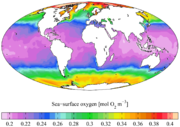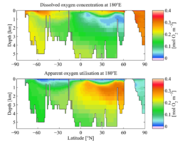
Oxygenation (environmental)
Encyclopedia
Environmental oxygenation can be important to the sustainability
of a particular ecosystem
. Insufficient oxygen (environmental hypoxia
) may occur in bodies of water such as pond
s and river
s, tending to suppress the presence of aerobic organism
s such as fish
. Deoxygenation increases the relative population of anaerobic organism
s such as plants and some bacteria
, resulting in fish kill
s and other adverse events. The net effect is to alter the balance of nature
by increasing the concentration of anaerobic over aerobic species
.
Oxygenation by water aeration can be part of the environmental remediation of a usually stagnant
body of water. For example, Bubbly Creek
in Chicago
, Illinois
, was hypoxic
(deficient in oxygen) due to its use as an open sewer
by Chicago's meat packing industry
but has been oxygenated by introducing compressed air
into its waters, increasing the fish population. A similar technique has previously been used in the Thames.

 In aquatic
In aquatic
environments, oxygen saturation is a relative measure of the amount of oxygen
(O2) dissolved in the water. Supersaturation can sometimes be harmful for organisms and cause decompression sickness. Dissolved oxygen (DO) is measured in standard solution units such as millilitres O2 per liter (ml/L), millimoles
O2 per liter (mmol/L), milligrams O2 per liter (mg/L) and moles O2 per cubic meter (mol/m3). For example, in freshwater under atmospheric pressure at 20°C, O2 saturation is 9.1 mg/L.
Solubility tables (based upon temperature) and corrections for different salinities and pressures can be found at the USGS web site. Tables such as these of DO in milliliters per liter (ml/L) are based upon empirical equations that have been worked out and tested:

Where ln is the natural logarithm
and the other variables take the following values:
To convert the calculated DO above from ml/L to mg/L, multiply the answer by (P/T)*0.55130, P=mmHg, T=Kelvin
Oxygen content in water can be measured by adding equal quantities of Manganese and Iodine ions in an alkaline solution to a sample of the water. This is then titrated against sodium thiosulfate with a starch indicator and the oxygen concentration determined. One such test is the Winkler test for dissolved oxygen
.
Sustainability
Sustainability is the capacity to endure. For humans, sustainability is the long-term maintenance of well being, which has environmental, economic, and social dimensions, and encompasses the concept of union, an interdependent relationship and mutual responsible position with all living and non...
of a particular ecosystem
Ecosystem
An ecosystem is a biological environment consisting of all the organisms living in a particular area, as well as all the nonliving , physical components of the environment with which the organisms interact, such as air, soil, water and sunlight....
. Insufficient oxygen (environmental hypoxia
Hypoxia (environmental)
Hypoxia, or oxygen depletion, is a phenomenon that occurs in aquatic environments as dissolved oxygen becomes reduced in concentration to a point where it becomes detrimental to aquatic organisms living in the system...
) may occur in bodies of water such as pond
Pond
A pond is a body of standing water, either natural or man-made, that is usually smaller than a lake. A wide variety of man-made bodies of water are classified as ponds, including water gardens, water features and koi ponds; all designed for aesthetic ornamentation as landscape or architectural...
s and river
River
A river is a natural watercourse, usually freshwater, flowing towards an ocean, a lake, a sea, or another river. In a few cases, a river simply flows into the ground or dries up completely before reaching another body of water. Small rivers may also be called by several other names, including...
s, tending to suppress the presence of aerobic organism
Aerobic organism
An aerobic organism or aerobe is an organism that can survive and grow in an oxygenated environment.Faculitative anaerobes grow and survive in an oxygenated environment and so do aerotolerant anaerobes.-Glucose:...
s such as fish
Fish
Fish are a paraphyletic group of organisms that consist of all gill-bearing aquatic vertebrate animals that lack limbs with digits. Included in this definition are the living hagfish, lampreys, and cartilaginous and bony fish, as well as various extinct related groups...
. Deoxygenation increases the relative population of anaerobic organism
Anaerobic organism
An anaerobic organism or anaerobe is any organism that does not require oxygen for growth. It could possibly react negatively and may even die if oxygen is present...
s such as plants and some bacteria
Bacteria
Bacteria are a large domain of prokaryotic microorganisms. Typically a few micrometres in length, bacteria have a wide range of shapes, ranging from spheres to rods and spirals...
, resulting in fish kill
Fish kill
The term fish kill, known also as fish die-off and as fish mortality, is a localized die-off of fish populations which may also be associated with more generalised mortality of aquatic life...
s and other adverse events. The net effect is to alter the balance of nature
Balance of nature
The balance of nature is a theory that says that ecological systems are usually in a stable equilibrium , which is to say that a small change in some particular parameter will be corrected by some negative feedback that will bring the parameter back to its original "point of balance" with the rest...
by increasing the concentration of anaerobic over aerobic species
Species
In biology, a species is one of the basic units of biological classification and a taxonomic rank. A species is often defined as a group of organisms capable of interbreeding and producing fertile offspring. While in many cases this definition is adequate, more precise or differing measures are...
.
Oxygenation by water aeration can be part of the environmental remediation of a usually stagnant
Water stagnation
Water stagnation occurs when water stops flowing. Stagnant water can be a major environmental hazard.-Dangers:Malaria and dengue are among the main dangers of stagnant water, which can become a breeding ground for the mosquitoes that transmit these diseases.Stagnant or Stailment water can be...
body of water. For example, Bubbly Creek
Bubbly Creek
Bubbly Creek is the nickname given to the South Fork of the Chicago River's South Branch, which runs entirely within the city of Chicago, Illinois. Gases bubbling out of the riverbed from the decomposition of blood and entrails dumped into the river by the local stockyards in the early 20th...
in Chicago
Chicago
Chicago is the largest city in the US state of Illinois. With nearly 2.7 million residents, it is the most populous city in the Midwestern United States and the third most populous in the US, after New York City and Los Angeles...
, Illinois
Illinois
Illinois is the fifth-most populous state of the United States of America, and is often noted for being a microcosm of the entire country. With Chicago in the northeast, small industrial cities and great agricultural productivity in central and northern Illinois, and natural resources like coal,...
, was hypoxic
Hypoxia (environmental)
Hypoxia, or oxygen depletion, is a phenomenon that occurs in aquatic environments as dissolved oxygen becomes reduced in concentration to a point where it becomes detrimental to aquatic organisms living in the system...
(deficient in oxygen) due to its use as an open sewer
Sanitary sewer
A sanitary sewer is a separate underground carriage system specifically for transporting sewage from houses and commercial buildings to treatment or disposal. Sanitary sewers serving industrial areas also carry industrial wastewater...
by Chicago's meat packing industry
Meat packing industry
The meat packing industry handles the slaughtering, processing, packaging, and distribution of animals such as cattle, pigs, sheep and other livestock...
but has been oxygenated by introducing compressed air
Compressed air
Compressed air is air which is kept under a certain pressure, usually greater than that of the atmosphere. In Europe, 10 percent of all electricity used by industry is used to produce compressed air, amounting to 80 terawatt hours consumption per year....
into its waters, increasing the fish population. A similar technique has previously been used in the Thames.


Water
Water is a chemical substance with the chemical formula H2O. A water molecule contains one oxygen and two hydrogen atoms connected by covalent bonds. Water is a liquid at ambient conditions, but it often co-exists on Earth with its solid state, ice, and gaseous state . Water also exists in a...
environments, oxygen saturation is a relative measure of the amount of oxygen
Oxygen
Oxygen is the element with atomic number 8 and represented by the symbol O. Its name derives from the Greek roots ὀξύς and -γενής , because at the time of naming, it was mistakenly thought that all acids required oxygen in their composition...
(O2) dissolved in the water. Supersaturation can sometimes be harmful for organisms and cause decompression sickness. Dissolved oxygen (DO) is measured in standard solution units such as millilitres O2 per liter (ml/L), millimoles
Mole (unit)
The mole is a unit of measurement used in chemistry to express amounts of a chemical substance, defined as an amount of a substance that contains as many elementary entities as there are atoms in 12 grams of pure carbon-12 , the isotope of carbon with atomic weight 12. This corresponds to a value...
O2 per liter (mmol/L), milligrams O2 per liter (mg/L) and moles O2 per cubic meter (mol/m3). For example, in freshwater under atmospheric pressure at 20°C, O2 saturation is 9.1 mg/L.
Solubility tables (based upon temperature) and corrections for different salinities and pressures can be found at the USGS web site. Tables such as these of DO in milliliters per liter (ml/L) are based upon empirical equations that have been worked out and tested:

Where ln is the natural logarithm
Natural logarithm
The natural logarithm is the logarithm to the base e, where e is an irrational and transcendental constant approximately equal to 2.718281828...
and the other variables take the following values:
| A1 | = | -173.4292 | B1 | = | -0.033096 | |
| A2 | = | 249.6339 | B2 | = | 0.014259 | |
| A3 | = | 143.3483 | B3 | = | -0.001700 | |
| A4 | = | -21.8492 | ||||
| T | = | temperature (kelvin Kelvin The kelvin is a unit of measurement for temperature. It is one of the seven base units in the International System of Units and is assigned the unit symbol K. The Kelvin scale is an absolute, thermodynamic temperature scale using as its null point absolute zero, the temperature at which all... ) |
S | = | salinity (g/kg) |
To convert the calculated DO above from ml/L to mg/L, multiply the answer by (P/T)*0.55130, P=mmHg, T=Kelvin
Oxygen content in water can be measured by adding equal quantities of Manganese and Iodine ions in an alkaline solution to a sample of the water. This is then titrated against sodium thiosulfate with a starch indicator and the oxygen concentration determined. One such test is the Winkler test for dissolved oxygen
Winkler test for dissolved oxygen
The Winkler test is used to determine the concentration of dissolved oxygen in water samples. Dissolved oxygen is widely used in water quality studies and routine operation of water reclamation facilities. An excess of manganese salt, iodide and hydroxide ions is added to a water sample causing...
.

